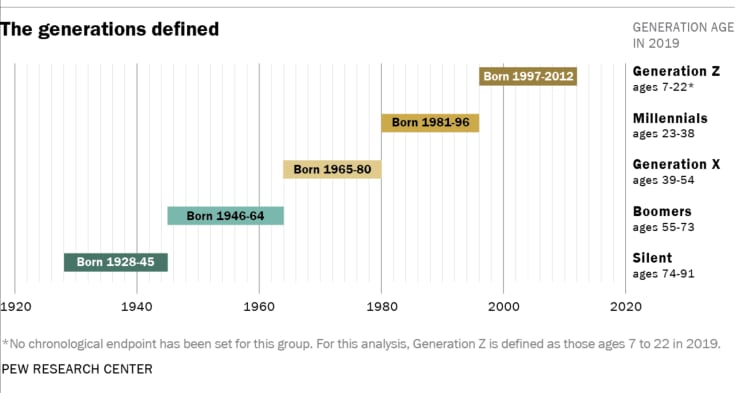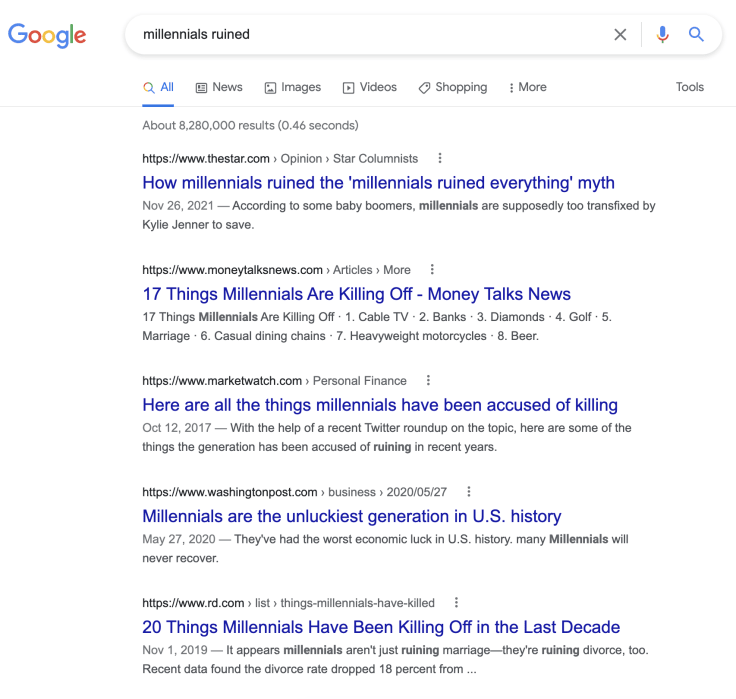Showing top 0 results 0 results found
Showing top 0 results 0 results found

Gen Zs and baby boomers can be as much as 60 years apart. Even if the youngest group isn’t the main generation you deal with today, they’ll become a major purchasing power over the next couple of years. What’s the best way to approach them, and how are they different from previous generations?
Boomers? Gen Z? What does it all mean?
A majority of sources are in agreement that the boomers are the people born between 1946 and 1964. The generations that followed include Generation X, millennials (AKA Generation Y), and Gen Z. Depending on the source, the beginning and end dates for each of these generations are slightly different. It’s especially tricky with millennials. While most experts put this group between 1981 and 1996, it’s not uncommon to find sources that extend that period to 2004.

Usually, a generation spans across 15 to 20 years. For some of us, that doesn’t seem like a long time. However, from a technological standpoint, it is an eternity. Think about what you were doing 20 years ago. Did you even think about smartphones back then? Only true visionaries had an idea of what the future of communication was going to look like.
The generations we’re going to talk about vary a lot, but one of the key differences is how they approach customer service.
Baby Boomers are more tech-savvy than you think
A generation that dates back to the years immediately following World War II, baby boomers are now 58 to 76-years-old. Out of all the groups that we’re going to discuss, they are the most traditional. A baby boomer facing a problem with a product or service is most likely to try and solve it face to face or over the phone.
If your business doesn’t have a physical location they can easily walk into, make sure to have your staff trained to effectively handle their problems by phone. At times, it will be more time-consuming, but the extra effort you put into helping a boomer is going to pay off.
However, the fact that they are the oldest group we’re talking about doesn’t mean they struggle with more technologically advanced means of communication. In fact, 68% own a smartphone, and 57% use social media. Some are going to be more fluent in using them than others, but the key takeaway here is not to exclude them from any of your communication channels.
While 84% of baby boomers still prefer to buy a product at a brick-and-mortar store, keep in mind that 86% research products online before they make a purchase. Considering the fact that they are the group with the highest disposable income among the four generations, adjusting your customer service to fully meet their needs is a no-brainer.
You won’t find more loyal customers than Generation X
Born between 1965 and 1980, they grew up watching their parents chase the American dream. As a consequence, they learned how to take care of themselves and how to make decisions independently at an early age.
We’re talking about the group that moved American entrepreneurship forward with the businesses they founded. They are more technologically advanced than their parents, with over 80% actively using social media. Facebook, LinkedIn, and Twitter are the social networks they are the most active on. Make sure you’re present on those platforms to react to your customers’ questions in a timely manner. While they prefer more modern support channels, they won’t shy away from a phone call or a face-to-face conversation.
One of the reasons for their distinctive shopping behavior is the Great Recession (2008), which highly influenced their spending habits. No other generation reads more reviews, or spends more time doing research, before deciding to buy a product. They highly value other people’s opinions, but they also want to see the real value behind what they buy.
If there’s one piece of advice on how to most effectively handle Gen Xers, it’s to get to the point and be as clear as possible. Both on your product pages and, more importantly, in your customer service efforts.
The people who belong to that group are among the most loyal customers. If you impress them with your customer service skills, their brand affinity is going to be even stronger when you offer them loyalty programs that provide additional rewards.
Avocado toast, anyone?
The first thing that pops into my mind when I think about millennials is avocado toast. I mean, where did this even come from? Being a millennial has felt like being a black sheep for the last couple of years. The people who were born between 1981 and 1996 have been killing industries and a lot of other things one by one, according to the media coverage.

Should millennials blame themselves for the ways they’re perceived? Partly, yes. But it’s not about their struggles in today’s world as much as it is about how they deal with customer service, or how they like to be dealt with.
They’re the first generation that was fully digitized, even though the Internet started getting some traction as late as the mid-90s, and the iPhone was unheard of until 2007. With technology being available to them from an early age, it turned out millennials were extremely fast learners who adapted to new, emerging technologies and communication channels as easily as toddlers who can operate tablets and smartphones almost from the moment they grab them.
Social media completely changed the way millennials communicate with each other. Businesses realized that they need to keep up with a group whose buying power is steadily increasing. They had to establish a presence on social media and use those channels to communicate with Gen Y. Plus, this was the only way to stay on top of reviews and product recommendations that millennials share so willingly across social networks. In fact, 82% of millennials claim that word of mouth is the deciding factor when it comes to making a purchase.
Millennials want their customer service communication to be simple and efficient. Most of the time, they’ll choose to tweet or send a direct message on their preferred social medium instead of using more traditional channels. I can serve as anecdotal evidence: There are few activities that I dislike more than a phone conversation, and 99% of the time, I am going to go for Messenger if I need to contact a brand. If you need more data to back it up, 81% of millennials use social media to interact with customer service, and 22% of them expect a reply from social media customer service within 10 minutes.
Gen Y is also happy to solve a lot of their problems on their own. Sometimes, a FAQ page is enough for them to find a solution. Make sure you address the most common questions your customers have. If it’s not enough, millennials will come your way, probably on social media, expecting a quick reply and a personalized approach based on the data collected from their previous purchases.
Turn Gen Z visitors into customers.
Free 14-day trial Omnichannel messaging

Gen Z takes the world by storm
Gen Z has taken the changes introduced by millennials even further. Born between 1997 and 2012, they’re the first generation growing up in an “always on” technological environment. Even though nearly half of Gen Zs are still in their life, the oldest are reaching their mid-twenties. They already have a job or two on their resumes and disposable income to spend on products and services from the brands they trust.
Businesses that want them to stick around need to tread lightly. Send out genuine, on-brand messages because Gen Z is notorious for its lack of brand loyalty. If your business truly wants to build a connection with the youngest group of consumers, an omnichannel presence is going to help you with that. They want to have as many channels to contact you as possible.
People have shorter and shorter attention spans, and it holds true for Gen Z. Businesses that want to captivate them with their customer service need to act fast. It’s worth the effort. 89% of those young people are happy to take to their social media accounts. They'll personally promote brands that provide them with top-notch customer service. It’s even more critical when you realize that 92% of them have multiple social media accounts to share information with their followers.
Another essential aspect that we didn’t cover while discussing the older generations is the option of purchasing goods directly from social media. It’s been a while since you could just click on an Instagram photo and buy a product directly through the app. While this shopping behavior is not exclusive to Generation Z, they’ll be the driving force behind it. 69% say they’d buy something directly from social media.
Young students and professionals already boast $360 billion in disposable income. Even if they aren’t the main generation you’re targeting right now, they’ll become a major purchasing power you won’t be able to ignore as they mature over the next couple of years.
By 2030, 1.3 billion Gen Z workers will replace 693 million retiring baby boomers in the labor market, and Gen Zers’ future earnings will reach $2 trillion in that time. They want to support brands that are vocal about what they believe in and aligned with how they perceive political and social problems.
To help you get ahead of the curve, we combined global market trends with our consumer data to prepare the Gen Z Communication Trends Report. It’ll help you build stronger customer relationships, navigate Gen Z’s values and beliefs, and turn visitors into customers.
Reevaluate your customer service
Despite the differences in customer service expectations, there’s one aspect that’s equally important to boomers, Gen X, and millennials. First and foremost, they all want to be heard and cared for.
Some of them will come up with problems so easy to solve (at least for you) that you’ll just want to roll your eyes. Other customers will surprise you with questions that you won’t be able to answer yourself, and you’ll have to reach out to your more technically advanced colleagues.
They represent different backgrounds and experiences and unless you serve a single generation, it’s in your best interest to bridge the generational gaps when talking to your customers.
Originally published March 26, 2020, updated September 19, 2022.







Comments